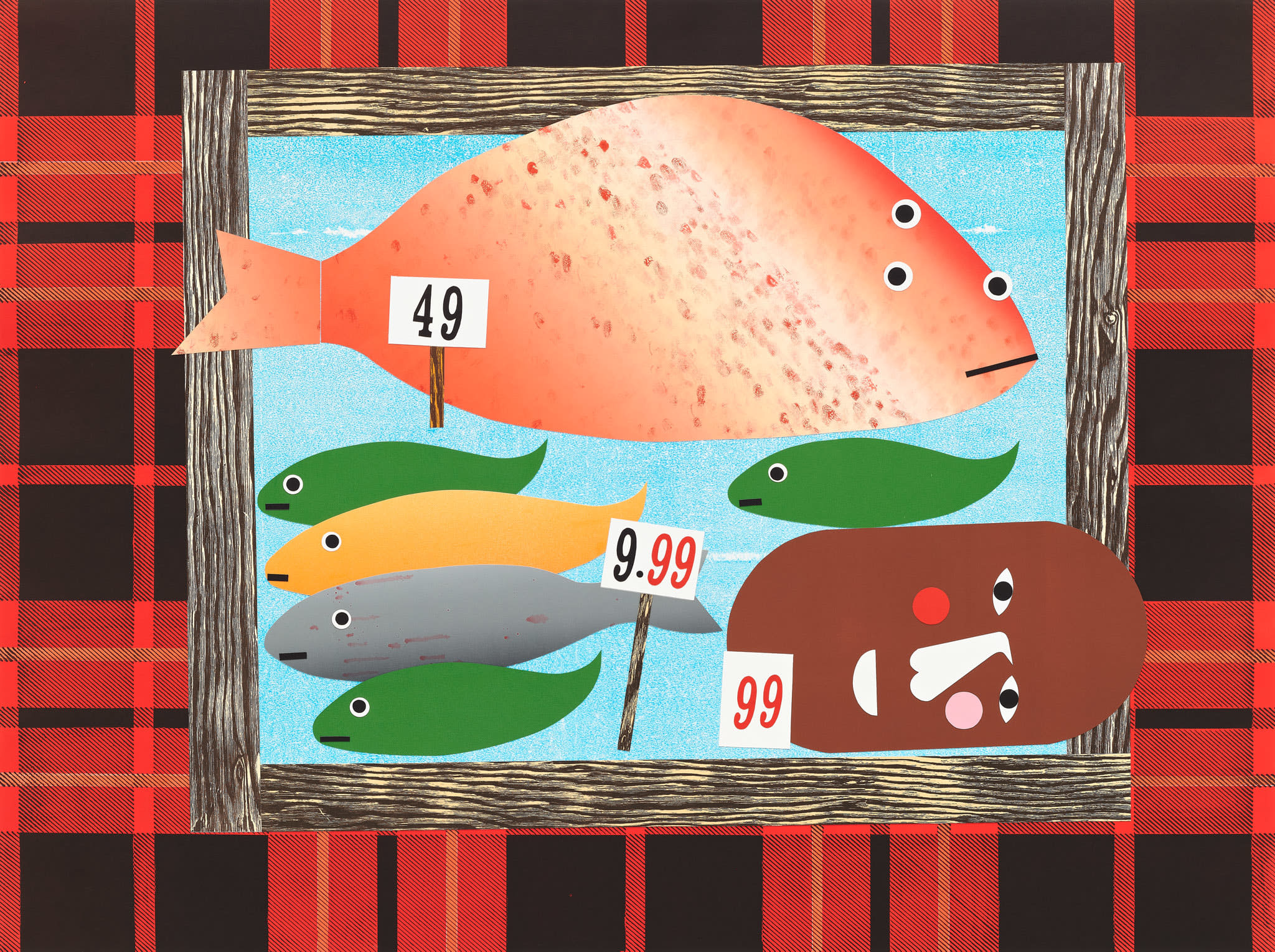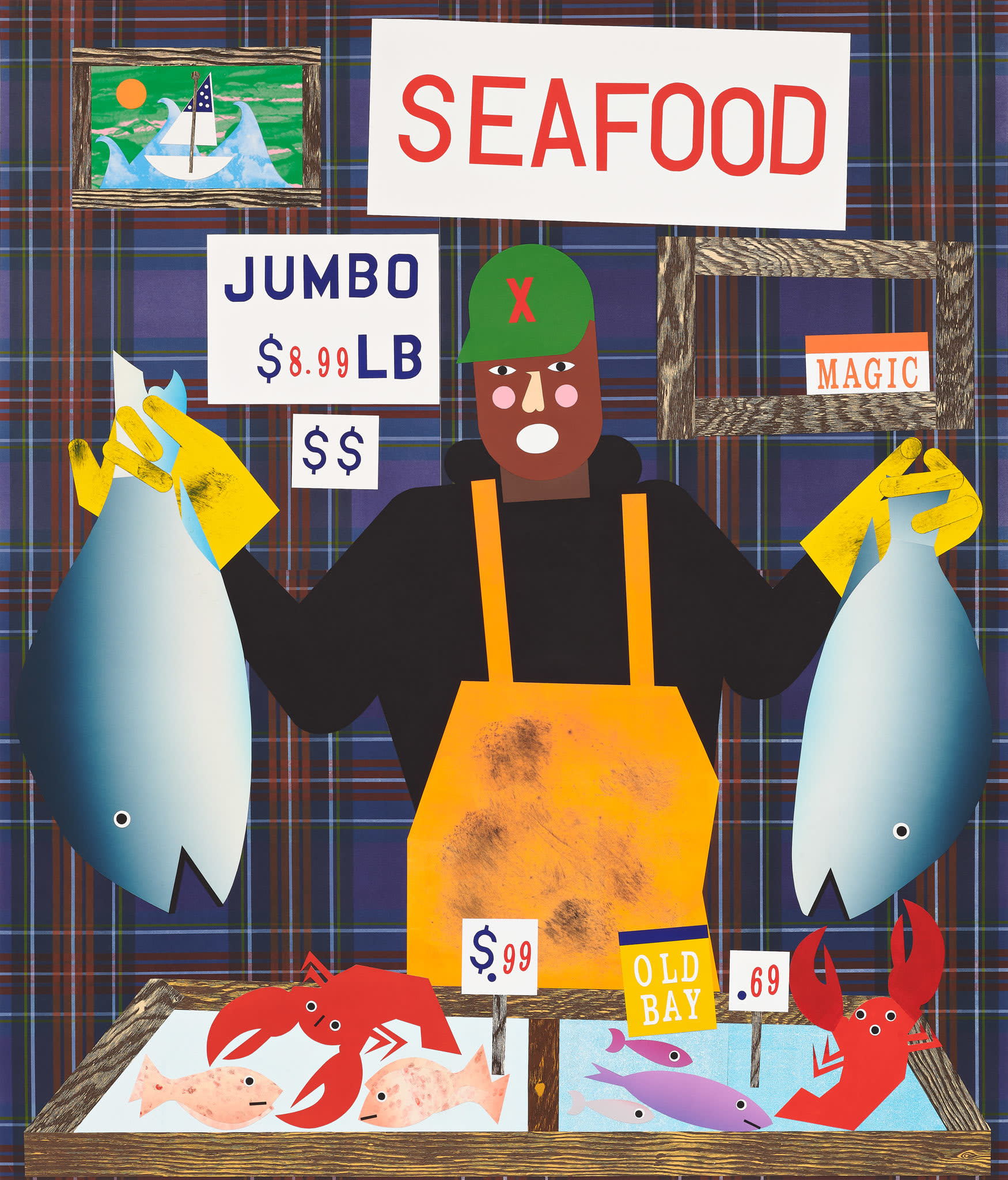-
Installation Shots
-
Press Release Text
After seeing Gordon Parks’s 1943–44 series documenting the fishing industry along the Atlantic coast, I immediately wondered about who was omitted from that documentation: African American fishermen. I was inspired to investigate the history of Black Americans in the commercial fishing industry—a legacy that is obscured. Fishing has deep roots in the Black community, yet the voices of Black fishermen are vastly underrepresented and their businesses in decline.
—Nina Chanel Abney
Through her use of vivid color, grand scale, and a combination of representation and abstraction, New York–based Chicago-born artist Nina Chanel Abney proposes a new type of history painting. For this exhibition, the culmination of her 2020 Gordon Parks Foundation Fellowship, Abney has created a series of collages inspired by Gordon Parks’s photographsof the fishing industry in and near Gloucester, Massachusetts, and at the Fulton Fish Market in New York City in the 1940s. Parks made these pictures on assignment for the Office of War Information, which tasked photographers with recording various aspects of American daily life, the workforce in various industries, and World War II mobilization. While Parks’s photographs focus on white laborers and their work sites, Abney imagines the Black workers whose contributions were often made invisible through the lens of mainstream narratives. Black people have long been a cornerstone of this country’s commercial fishing industry, particularly along the Gulf Coast—in Texas, Louisiana, Mississippi, Alabama, and Florida. Yet a series of man-made catastrophes, from redlining to environmental racism, have threatened their livelihood and existence. In the 1970s and 1980s, for example, Black oysterers had to fight redlining laws that disproportionally limited their work on the richest oyster beds and waterways. Along the Gulf Coast, Black fishermen who make their living from shrimp and oysters continue to suffer from the impact of Hurricane Katrina in 2005 and the 2010 BP oil spill. In Chesapeake Bay, the presence of Black workers in the fishing industry has declined from 90 percent to nearly zero.
As a result of systemic racism, Black fishermen to this day have little access to the capital and resources necessary to grow and sustain their businesses. By showing Abney’s collages alongside Parks’s photographs from decades ago, Fishing Was His Life aims to illuminate the erased narratives and rich cultural legacy of African Americans in the commercial fishing industry.
NINA CHANEL ABNEY IS A 2020 GORDON PARKS FOUNDATION FELLOW.
-
Works
-
 Captain F.M., 2022Collage on panelPaper size: 60 x 60 inches
Captain F.M., 2022Collage on panelPaper size: 60 x 60 inches
Framed Dimensions: 61 1/4 x 61 1/4 x 1 3/8 inches -
 #Bruthas Who #fish, 2022Collage on panelPaper Size: 67 1/2 x 78 1/4 inches
#Bruthas Who #fish, 2022Collage on panelPaper Size: 67 1/2 x 78 1/4 inches
Framed dimensions: 68 3/8 x 79 1/2 x 1 3/8 inches -
 Fish Head, 2022Collage on panelPaper size: 35 1/4 x 47 1/8 inches
Fish Head, 2022Collage on panelPaper size: 35 1/4 x 47 1/8 inches
Framed dimensions: 36 7/16 x 48 7/16 x 1 3/8 inches -
 Fish Tales, 2022Collage on panelPaper size: 46 3/4 x 35 1/2 inches
Fish Tales, 2022Collage on panelPaper size: 46 3/4 x 35 1/2 inches
Framed Dimensions: 48 x 36 11/16 x 1 3/8 inches -
 Johnny X, 2022Collage on panelPaper Size: 78 x 66 3/4 inches
Johnny X, 2022Collage on panelPaper Size: 78 x 66 3/4 inches
Framed Dimensions: 79 1/4 x 68 x 1 3/8 inches -
 My Old Bae, 2022Collage on panelPaper size: 56 1/2 x 36 1/4 inches
My Old Bae, 2022Collage on panelPaper size: 56 1/2 x 36 1/4 inches
Framed Dimensions: 57 3/4 x 37 1/2 x 1 3/8 inches -
 Sea & Seize, 2022Collage on panelPaper size: 62 1/8 x 71 1/2 inches
Sea & Seize, 2022Collage on panelPaper size: 62 1/8 x 71 1/2 inches
Framed dimensions: 63 3/8 x 72 3/4 x 1 3/8 inches -
 Black People (BP), 2022Triptych collage on panelPaper size: 72 x 84 inches, each panel
Black People (BP), 2022Triptych collage on panelPaper size: 72 x 84 inches, each panel
Framed Dimensions: 73 1/4 x 85 1/4 x 1 3/8, each -
 Anthony, 2022Collage on panelPaper size: 46 3/4 x 35 1/2 inches
Anthony, 2022Collage on panelPaper size: 46 3/4 x 35 1/2 inches
Framed Dimensions: 47 7/8 x 36 11/16 x 1 3/8
-
-
Related Exhibitions










